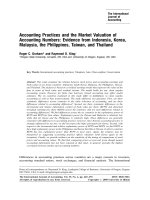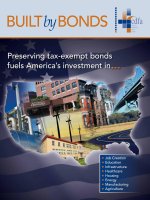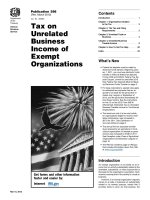IRS audits of tax exempt organizations policies practices and procedures bruce r hopkins
Bạn đang xem bản rút gọn của tài liệu. Xem và tải ngay bản đầy đủ của tài liệu tại đây (1.82 MB, 430 trang )
IRS Audits of Tax-Exempt
Organizations
Policies, Practices, and Procedures
Bruce R. Hopkins
John Wiley & Sons, Inc.
IRS Audits of Tax-Exempt
Organizations
IRS Audits of Tax-Exempt
Organizations
Policies, Practices, and Procedures
Bruce R. Hopkins
John Wiley & Sons, Inc.
This book is printed on acid-free paper.
Copyright 2008 by John Wiley & Sons, Inc. All rights reserved.
Published by John Wiley & Sons, Inc., Hoboken, New Jersey.
Published simultaneously in Canada.
No part of this publication may be reproduced, stored in a retrieval system, or transmitted in any form or
by any means, electronic, mechanical, photocopying, recording, scanning, or otherwise, except as
permitted under Section 107 or 108 of the 1976 United States Copyright Act, without either the prior
written permission of the Publisher, or authorization through payment of the appropriate per-copy fee to
the Copyright Clearance Center, Inc., 222 Rosewood Drive, Danvers, MA 01923, 978-750-8400, fax
978-646-8600, or on the web at www.copyright.com. Requests to the Publisher for permission should be
addressed to the Permissions Department, John Wiley & Sons, Inc., 111 River Street, Hoboken, NJ 07030,
201-748-6011, fax 201-748-6008, or online at www.wiley.com/go/permissions.
Limit of Liability/Disclaimer of Warranty: While the publisher and author have used their best efforts in
preparing this book, they make no representations or warranties with respect to the accuracy or
completeness of the contents of this book and specifically disclaim any implied warranties of
merchantability or fitness for a particular purpose. No warranty may be created or extended by sales
representatives or written sales materials. The advice and strategies contained herein may not be suitable
for your situation. You should consult with a professional where appropriate. Neither the publisher nor
author shall be liable for any loss of profit or any other commercial damages, including but not limited to
special, incidental, consequential, or other damages.
For general information on our other products and services, or technical support, please contact our
Customer Care Department within the United States at 800-762-2974, outside the United States at
317-572-3993 or fax 317-572-4002.
Wiley also publishes its books in a variety of electronic formats. Some content that appears in print may not
be available in electronic books.
For more information about Wiley products, visit our Web site at www.wiley.com.
Library of Congress Cataloging-in-Publication Data:
Hopkins, Bruce R.
IRS audits of tax-exempt organizations : policies,
practices, and procedures / Bruce R. Hopkins.
p. cm.
Includes index.
ISBN 978-0-470-11516-9 (cloth)
1. Nonprofit organizations–Taxation–Law and legislation–
United States. 2. Charitable uses, trusts, and
foundations–Taxation–United States. 3. Tax auditing–United States. I. Title.
KF6449.H66 2008
343.7305’266–dc22
2007043561
Printed in the United States of America.
10 9 8 7 6 5 4 3 2 1
This book is dedicated to Scott C. Syphax; he knows why.
About the Author
BRUCE R. HOPKINS is a senior partner with the firm Polsinelli Shalton
Flanigan Suelthaus PC. He is also the author of more than 20 books on
nonprofit tax and law issues, including The Law of Tax-Exempt Organizations, 9th
ed., Planning Guide for the Law of Tax-Exempt Organizations, Nonprofit Law Made
Easy, Charitable Giving Law Made Easy, 650 Essential Nonprofit Law Questions
Answered, The Law of Fundraising, 3rd ed., Private Foundations: Tax Law and
Compliance, 2nd ed., The Tax Law of Charitable Giving, 3rd ed., The Law of
Intermediate Sanctions, and The Law of Tax-Exempt Healthcare Organizations, 2nd
ed., as well as the monthly newsletter Bruce R. Hopkins’ Nonprofit Counsel, all
published by Wiley.
Mr. Hopkins received the 2007 Outstanding Nonprofit Lawyer Award
(Vanguard Lifetime Achievement Award) from the American Bar Association, Section of Business Law, Committee on Nonprofit Corporations. He is
listed in The Best Lawyers in America, Nonprofit Organizations/Charities Law,
2007–2008.
Ⅲ
vii
Ⅲ
Contents
Preface xix
Book Citations
xxiii
Chapter One: IRS Audits of Tax-Exempt Organizations: Fundamentals
§ 1.1
Introduction to IRS Exempt Organizations Audit Procedures 2
§ 1.2
Reasons for IRS Audits 4
§ 1.3
IRS Audit Issues: Introduction 5
§ 1.4
IRS Audit Procedures in General 6
§ 1.5
Tax-Exempt Organizations’ Rights 7
§ 1.6
Types of IRS Examinations 8
(a) Field Examinations 8
(b) Office and Correspondence Examinations 9
(c) Team Examinations 9
(d) Compliance Check Projects 10
§ 1.7
IRS Audit Controversy 11
§ 1.8
IRS Summons Authority 12
§ 1.9
Technical Advice 13
(a) General Procedures in Exempt Organizations Context 14
(b) Pre-Submission Conferences 15
(c) Contents of TAM Requests 16
(d) Handling of TAM Requests 17
(e) Appeals of Decisions to Not Seek Advice 17
(f) Withdrawal of TAM Requests 18
(g) Conference Scheduling 18
(h) IRS Use of TAMs 19
(i) Effect of TAM 20
(j) Limited Retroactive Effect of TAM 20
(k) Future Use of TAMs 21
§ 1.10 Closing Agreements 21
(a) Overall Purpose of Closing Agreements 22
(b) Authority and Function 22
(c) Scope 23
(d) Finality 24
(e) Closing Agreements in Exempt Organizations Context 24
§ 1.11 Freedom of Information Act 26
§ 1.12 Retroactive Revocation of Tax-Exempt Status 27
§ 1.13 Expansion of IRS Exempt Organizations Audit Activity 30
§ 1.14 Current and Future Focus of IRS Exempt Organizations Audits 32
Ⅲ ix Ⅲ
1
CONTENTS
Chapter Two: Organization of the IRS
§ 2.1
Structure of Department of Treasury 37
(a) Treasury Department in General 38
(b) Treasury Inspector General for Tax Administration 39
§ 2.2
IRS in General 39
§ 2.3
Tax Exempt and Government Entities Division 43
(a) Overall Organization 43
(b) Customer Profile 47
(c) Operations 48
(d) Enforcement Function 50
§ 2.4
Headquarters Mission 51
(a) Senior Technical Advisor 51
(b) Planning 52
(c) Finance 52
(d) Communications and Liaison 52
(e) Business Systems Planning 53
(f) Research and Analysis 53
§ 2.5
Examinations Office 53
§ 2.6
Customer Education and Outreach 55
§ 2.7
Rulings and Agreements 56
§ 2.8
Program Management 57
§ 2.9
Customer Accounts Services 58
§ 2.10 IRS Administrative Functions 58
§ 2.11 Appeals 61
(a) Organization, Priorities, and Mission 62
(b) Appeals Function and Tax-Exempt Organizations 63
§ 2.12 Office of National Taxpayer Advocate 64
(a) Mission Fulfillment 64
(b) Organization 65
(c) General Rules 65
(d) Systemic Advocacy 66
(e) TAS and Tax-Exempt Organizations 66
§ 2.13 Practice Before IRS 67
37
Chapter Three: Managing Tax-Exempt Organizations IRS Audits
§ 3.1
Pre-Audit Precautions 70
(a) Review Governing Instruments 70
(b) Review Operations 72
(c) Review Books and Records 73
(d) Review Publications 74
(e) Review Correspondence 76
(f) Review Minutes 76
(g) Review Federal Returns 78
(h) Review Contracts 79
(i) Conflict-of-Interest Policy 81
69
Ⅲ x
Ⅲ
CONTENTS
§ 3.2
§ 3.3
§ 3.4
§ 3.5
§ 3.6
§ 3.7
§ 3.8
§ 3.9
(j) Other Documents 82
(k) Review Web Site 85
(l) Employment Taxes 86
(m) Media Coverage 86
(n) Testaments 86
(o) Governance 87
(p) Legal Audit 89
Winning Audit Lottery: Initial Steps and Reactions 89
(a) Telephone Call 90
(b) Notice of Examination 90
(c) Documents Requested 90
(i) Organizational Documents 90
(ii) Operational Documents 90
(iii) Books and Records 91
(d) Get Organized 91
(e) Contact Person 91
(f) Communications Strategy 91
(g) Know the Cast 91
(h) Office Facilities for IRS 92
(i) Initial and Other Interviews 93
(j) First Impressions 94
Audit Unfolds: Ongoing Steps 94
(a) Documents 94
(b) Stay Calm, Things Take Time 94
(c) Audit Outcomes 95
(d) Perspective 95
Power of Attorney 96
Interacting with IRS Examiners 97
(a) Coping with Examiners 97
(b) Tours 99
(c) Point Person 100
(d) Documents 101
Documents Likely to Be Requested 101
Qualified Amended Returns 102
Issue Elevation 103
(a) Definition of Elevation 103
(b) Definition of Issue 104
(c) Why Issues Are Elevated 104
(d) Elevation to Inform Managers or Executives 105
(e) Elevation to Obtain Decision 106
(f) Issues That Are Candidates for Elevation 107
(g) Referral to or Consultation with Counsel 108
Appeals 109
(a) IRS District Office Action 109
Ⅲ xi Ⅲ
CONTENTS
§ 3.10
§ 3.11
§ 3.12
§ 3.13
(b) Regional Office Appeal 109
(c) Proposed Additional Tax 110
Parade of IRS Forms 111
(i) Notice of Examination 112
(ii) Information Document Requests 113
(iii) Power of Attorney 113
(iv) Explanation of Items 113
(v) Exempt Organizations—Report of Examination (Proposed
Status Changes 113
(vi) Consent to Proposed Action—Section 7428 114
(vii) Thirty-day Letter 114
(viii) Appeals Acknowledgment Letter 114
(ix) Consent to Extend the Statute of Limitations 114
Statute of Limitations 115
An Unwanted Outcome 116
Litigation 117
(a) General Rules 118
(b) Declaratory Judgment Rules 120
(i) General Requirements 120
(ii) Exhaustion of Administrative Remedies 125
(iii) Deductibility of Contributions 126
(iv) Administrative Record 127
(v) Development of Law 130
(c) Other Approaches 132
Chapter Four: IRS Compliance Check Projects
§ 4.1
Compliance Check Projects Program 136
§ 4.2
Concept of Market Segment Study 137
§ 4.3
Executive Compensation Compliance Initiative 139
(a) Law Backdrop 139
(b) Background 142
(c) Methodology 142
(d) Examination Phase 143
(e) Findings 143
(f) Conclusions 144
(g) Lessons Learned and Recommendations 145
§ 4.4
Political Activities Compliance Initiative 146
(a) Law Backdrop 146
(b) 2004 Election Initiatives 147
(c) 2006 Election Initiatives 148
(d) 2007 Update 149
§ 4.5
Hospital Compliance Project 150
(a) Law Backdrop 150
(b) Methodology and Process 151
Ⅲ xii
Ⅲ
135
CONTENTS
§ 4.6
§ 4.7
§ 4.8
§ 4.9
(c) TIGTA Review 154
(d) IRS Interim Report 154
(e) Future Developments 156
Intermediate Sanctions Compliance Reporting 156
(a) Law Backdrop 156
(b) Compliance Project 157
Fundraising Costs Reporting 157
(a) Law Backdrop 157
(b) Compliance Project 157
Tax-Exempt Bonds Recordkeeping Compliance 161
(a) Law Backdrop 158
(b) Compliance Project 158
Successor Member Interest Contributions 159
(a) Law Backdrop 159
(b) Compliance/Examination Project 161
Chapter Five: IRS Tax-Exempt Organizations Examination Procedures
§ 5.1
Director, Exempt Organizations Examinations 167
§ 5.2
Planning, Classifying, and Selecting Returns; Processing Claims
(a) Inventory and Classification System 168
(b) Examination Process 170
(c) Claims Processing 171
(d) Joint Committee Claim Cases 171
§ 5.3
Information Items 171
(a) Types and Sources 171
(b) General Procedures 172
(c) Classification Procedures 174
(d) Referral Committee 176
§ 5.4
Other IRS Preexamination Processes 177
(a) Recordkeeping System 177
(b) Case Assignment Guide 178
(c) Preexamination Guidelines 182
(d) Examination Objectives 183
(e) Beginning of Examination Process 184
(f) Group Manager Involvement 184
(g) Statute of Limitations 185
§ 5.5
Examination Cycle 189
§ 5.6
Conflicts of Interest 189
§ 5.7
Prohibition on Executive Branch Influence 190
§ 5.8
Consecutive Examinations 191
§ 5.9
Repetitive Examinations 191
§ 5.10 Return Surveys 192
§ 5.11 Preexamination Procedures: Overview 193
§ 5.12 Review of Return 194
§ 5.13 Review of Accompanying IRS Documents 195
Ⅲ
xiii
Ⅲ
165
168
CONTENTS
§ 5.14
§ 5.15
§ 5.16
§ 5.17
§ 5.18
§ 5.19
Determination File 196
Research and Assistance 196
Case Chronology Record 197
Workpaper Summary 198
Commencement of Examination 198
(a) Initial Taxpayer Contact 198
(i) Definition 198
(ii) Contact Person 199
(iii) Initial Contact 200
(iv) Examination Transfers 201
(v) Initial Information Document Request 203
(vi) Planning Initial Interview 205
(b) On-Site Examinations 207
(i) Quality Examinations 207
(ii) Examination Objectives 208
(iii) Customer Service 208
(iv) National Standard Time Frames 209
(v) Initial Examination Scope 210
(c) Limited Scope Examinations 211
(d) Evaluation of Internal Controls 211
(e) Examiner Workpapers 213
(f) Examination Techniques 214
(g) Initial Interview 216
(h) Third-Party Contacts 217
(i) Taxpayer Confidentiality Privilege 218
(j) Place of Examination 218
Examination Unfolds 218
(a) Tour of Facilities 218
(b) Examination of Documents 219
(i) Books and Records 219
(ii) Governing Instruments 220
(iii) Minutes 220
(iv) Publications 221
(v) Web Site 221
(vi) Operating Manuals 221
(vii) Contracts 221
(viii) Correspondence Files 221
(ix) Financial Records 222
(c) Sampling Techniques 225
(d) Income Analysis 226
(e) Disbursement Analysis 226
(f) Filing Requirements 227
(g) Expense Allocations 228
(h) Balance Sheet Analysis 228
(i) Tax Liabilities 229
Ⅲ xiv
Ⅲ
CONTENTS
§ 5.20
§ 5.21
§ 5.22
§ 5.23
§ 5.24
§ 5.25
§ 5.26
§ 5.27
§ 5.28
§ 5.29
§ 5.30
§ 5.31
§ 5.32
§ 5.33
§ 5.34
§ 5.35
(j) Accuracy of Returns 229
(k) Penalties 229
(l) Issue Development 230
(m) Exempt Organization–Caused Delays 231
(n) Developing and Documenting Facts 231
(o) Collecting and Recording Facts 232
(p) Preparation and Issuance of Summons 233
(q) Sharing of Issues 233
Burden of Proof 234
Revocation of Tax Exemption 234
Effective Date of Revocation or Modification 234
Technical Advice 234
Terminations 234
Inadequate Records 238
Revocation Due to Inadequate Records or Failure to Provide Requested
Information 240
Issues Subject to Declaratory Judgment 241
IRS Inability to Locate Organization 241
Technical Advisor Issues 242
Suspended Issues 242
Law Research by Examiners 243
Closing Letters; Examination Reports 244
(a) Terminology 244
(b) Examination Report Forms 248
Examination Outcomes 246
(a) No-Change Examinations 246
(b) No-Change with Written Advisory Examinations 247
(c) Change Cases 248
(d) Presentation of Issues in Examination Reports 249
(e) Revocation of Exempt Status 250
(f) Modification of Exempt Status 250
(g) Reclassification of Public Charity, Foundation Status 251
(h) Modification of Operating Foundation Status 252
(i) Unrelated Business Issues 252
(j) Private Foundation Excise Taxes 254
(k) Non–Private Foundation Excise Taxes 254
(l) Nonexempt Charitable Trusts Examinations 256
Claims 257
Basic IRS Examination Forms 258
(a) Explanation of Items 258
(b) Internal Transmittal Letter 259
(c) Report of Examination (Tax Changes) 260
(d) Report of Examination (Status Changes) 261
(e) Excise Tax Audit Changes 262
Ⅲ
xv Ⅲ
CONTENTS
Chapter Six: Church Tax Audit Procedures
§ 6.1
Constitutional Law Background 264
§ 6.2
Statutory Law Background 265
§ 6.3
Statutory Law Overview 266
§ 6.4
Inapplicability of Church Audit Procedures 267
§ 6.5
Church Records 270
§ 6.6
Church Tax Inquiries 271
(a) Reasonable Belief Standard 271
(b) Written Notice to Church 271
§ 6.7
Church Tax Examinations 273
(a) Notice of Examination 274
(b) Scope of Examination 275
(c) Examination Outcomes 276
§ 6.8
Summons Enforcement 277
§ 6.9
Prototype Scenario 280
(a) IRS Becomes Suspicious 280
(b) Notice of Church Tax Inquiry 281
(c) Notice of Church Tax Examination 281
(d) Conference 282
§ 6.10 Two-Year Completion Rule 282
§ 6.11 Ninety-Day Completion Rule 283
§ 6.12 Special Limitation Periods 284
§ 6.13 Limitations on Additional Inquiries and Examinations 286
§ 6.14 Limited Remedy for IRS Violations of Procedures 287
§ 6.15 Exhaustion of Administrative Remedies Rule 288
§ 6.16 Interplay with Intermediate Sanctions Rules 288
263
Chapter Seven: Tax-Exempt Organizations Examination Issues
289
§ 7.1
Categories of Tax-Exempt Organizations 290
(a) Single-Parent Title-Holding Corporations 290
(b) Charitable, Educational, and Like Organizations: General Rules 291
(c) Religious Organizations 293
(d) Private Schools 294
(e) Public Interest Law Firms 295
(f) Educational Organizations 296
(g) Scientific Organizations 296
(h) Amateur Athletic Sports Organizations 297
(i) Social Welfare Organizations 298
(j) Local Associations of Employees 299
(k) Labor Organizations 299
(l) Agricultural and Horticultural Organizations 300
(m) Business Leagues 301
(n) Social and Recreational Clubs 302
(o) Fraternal Societies 304
(p) Voluntary Employees’ Beneficiary Associations 305
Ⅲ xvi
Ⅲ
CONTENTS
§ 7.2
§ 7.3
§ 7.4
§ 7.5
§ 7.6
§ 7.7
(q) Teachers’ Retirement Fund Associations 307
(r) Mutual and Cooperative Organizations 307
(s) Cemetery Companies 309
(t) Credit Unions 309
(u) Small Insurance Companies 309
(v) Crop Financing Organizations 310
(w) Supplemental Unemployment Benefit Trusts 310
(x) Veterans’ Organizations 311
(y) Black Lung Benefit Trusts 312
(z) Multi-Parent Title-Holding Organizations 313
(aa) Apostolic Organizations 313
(bb) Political Organizations 313
(cc) Health Maintenance Organizations 314
Public Charity and Private Foundation Status 315
(a) Donative Publicly Supported Organizations Issues 315
(b) Facts-and-Circumstances Test 316
(c) Service Provider Publicly Supported Organizations Issues 316
(d) Supporting Organizations Issues 317
(e) Public Safety Organizations 319
(f) Workpaper Documentation 319
(g) Private Foundations 320
(h) Other Issues 321
Nonexempt Charitable Trusts and Split-Interest Trusts 323
(a) Nonexempt Charitable Trusts 324
(b) Split-Interest Trusts 324
(c) Abusive Trusts 325
Unrelated Business Activities 326
Reporting Requirements 326
Fundraising 327
(a) Advertisements of Fundraising Activities 327
(b) Disclosure of Nondeductible Contributions 327
(c) Disclosure of Quid Pro Quo Contributions 328
(d) Unrelated Business Rules 328
(e) Non-Cash Charitable Contributions 329
(f) Internet Fundraising 330
(g) Annual Reporting 331
Gaming 332
(a) Preexamination Analysis 332
(b) Initial Contact Interview 333
(c) Analysis of Bingo Activity 333
(d) Analysis of Pull-Tab Activity 335
(e) Unrelated Business Activities 335
(f) Qualification for Exempt Status 336
(g) Public Charity Status 336
Ⅲ xvii
Ⅲ
CONTENTS
(h) Related Entities 337
(i) Other Matters 337
Appendixes 339
A Sources of the Law 339
B
IRS’s ‘‘Good Governance’’ Principles (Draft) 355
C
Synopsis of the Law of Tax-Exempt Organizations 361
D Exempt Organizations Fiscal Year 2008 Analysis 383
Table of Cases 389
Table of IRS Revenue Rulings 393
Table of IRS Revenue Procedures 395
Index 397
Ⅲ xviii
Ⅲ
Preface
John Wiley & Sons and yours truly have spent thousands of hours spanning
more than 30 years producing over 20 books about federal and state law
applicable to nonprofit organizations. Most of this work focuses on the federal
tax law, with emphasis on tax exemption. Thus, by necessity, all of these books,
some to a greater extent than others, pertain to law that is formulated, shaped,
and enforced by your author’s favorite government agency, the Internal
Revenue Service.
Most books about the IRS are sensational, written to fan the populace’s
flames of hatred and fear of the IRS. One of the best of this genre is Inside
Internal Revenue: A Report to the Taxpayer, written by a fellow named William
Surface back in 1967 (New York: Coward-McCann, this publisher was probably
audited by the IRS soon thereafter). A blurb from the dust jacket nicely sets
the tone: ‘‘Here is the first authoritative report on the biggest, toughest,
and heretofore most mysterious and sacrosanct money-collecting industry on
earth—the Internal Revenue Service.’’ This book ‘‘penetrates the propaganda,
the scares, the innuendoes, and the threats to tell exactly how the big bite
operates.’’ It is elsewhere reported that this distaste of the agency predates the
1960s: ‘‘But the fledgling nation [the United States] was soon to find its very
existence threatened with the outbreak of the War of 1812 (1807–10), during
which the British marched into Washington, D.C., and, with the help of local
residents, burned the Internal Revenue Service to the ground. Tragically, it
was rebuilt. . .’’ (Dave Barry’s History of the Millennium (So Far) (New York:
G. P. Putnam’s Sons, 2007) at 20). (Mr. Barry has been audited by the IRS.)
As this book was being formulated, very little in the way of serious
writings about the organization and operation of the IRS existed. Authoritative
information about IRS audits was, at best, skimpy. (Not that there weren’t
plenty of writings about IRS audits. Mr. Surface, for example, attempting to
explain the agency’s ‘‘dual image’’ of being helpful to compliant taxpayers
(hence Internal Revenue Service) and simultaneously relentless in the collection
of taxes and penalties, wrote that the IRS is ‘‘comparable to a beautiful woman
who unpredictably kisses and kicks with equal passion’’ (at 5).)
As is discussed in this book, IRS audits of tax-exempt organizations are
increasing. This is complemented by the relatively new phenomena of compliance check projects, where hundreds of exempt organizations are examined,
usually as to a single issue, such as hospitals’ compliance with the charity care
requirement, public charities’ involvement in political campaign activity, or
tax-exempt bond beneficiaries’ adherence to certain recordkeeping rules.
Ⅲ
xix
Ⅲ
PREFACE
Given this lack of information and concomitant rise in the IRS exempt
organizations’ audit activity, conception of the need for this book was easy.
Both executives and representatives of tax-exempt organizations need to know
more than they usually do when caught up in an IRS examination. (There
are veteran lawyers out there bearing the battle scars of exempt organization
audits, but they are scarce.) When writing a book, however, there is a gap
between conception and production. The breadth and depth of this gap will
vary (dependent largely on the writer’s organizational and disciplinary skills,
and also on the availability of underlying information), but there always is
one. In the case of this book, the gap was a chasm; this book, without doubt,
proved to be the most difficult one that your author has written. Conception:
easy; production: hard; gap: very wide and very deep.
The reason for this tribulation is as mentioned: an absence of solid information about the IRS and even less material about its tax-exempt information
audit policies and practices. IRS audits are a subject few taxpayers care to
contemplate; the IRS does not go out of its way to engage in discourse on the
matter. Ferreting out the information that lies between these covers was quite
the exercise.
The book, of course, is intended to be of assistance to those who manage
tax-exempt organizations that become enmeshed in an IRS audit and those
who represent the organizations (usually lawyers and/or accountants) in
connection with the examination. This objective is achieved in two ways. One,
the parties should understand the structure and operations of the IRS as they
relate to audits of exempt organizations. Two, the parties need to know what to
expect in the exempt organization audit process—how to prepare for it, how
to cope with it, how to (ideally, successfully) survive it. Exempt organization
audits are not precisely alike but there are plenty of commonalties. (Wonderful
phrases emanate from the realm of IRS EO audits, uttered mostly by Marc
Owens; two of the best pertain to proper advance preparation for an IRS audit
(‘‘hardening the target’’) and being selected for an IRS audit (‘‘winning the
audit lottery’’). The IRS has some intriguing phraseologies in this context as
well but, somehow, they are not as entertaining.)
Unlike your author’s other books, there is not much law on which this
one rests. No statutes, tax regulations, court opinions, or the like guide the
way and neatly formulate the process (except, as discussed in Chapter 6, for
churches). (There is the formidable Internal Revenue Manual, more about which
in Chapters 1 and 7.) Certain aspects of the audit steps are treated in detail in
the law, such as the IRS’s summons authority and the availability of technical
advice; this book is an attempt to stitch these details together and provide
the big IRS exempt organizations’ audit picture. War stories are kept to a
minimum, but there is a sprinkling of them to illustrate some of the snags that
can pop up along the way.
Ⅲ
xx
Ⅲ
PREFACE
Your author does not wish an IRS audit on any tax-exempt organization.
Should one occur, however, this book is designed to help. To those involved,
be alert, be cautious, be patient. Think of the IRS as that beautiful woman.
Thanks to my senior editor, Susan M. McDermott, for seeing me through
this project with her constant encouragement, and to Natasha Andrews-Noel,
production editor, for her skills in narrowing the gap and attending to production of the book.
Bruce R. Hopkins
March 2008
Ⅲ
xxi Ⅲ









